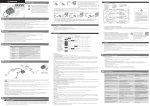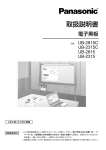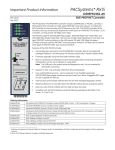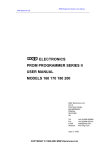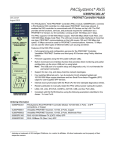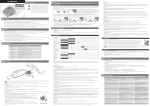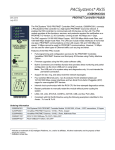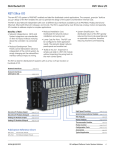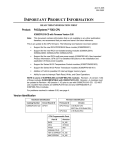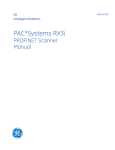Download GFK2817K RXICTL000BH IPI - GE Intelligent Platforms: Support
Transcript
IMPORTANT PRODUCT INFORMATION GFK-2817K April 2014 PACSystems* RXi Controller - ICRXICTL000-BH, version 8.15 Product Documentation PACSystems RXi ICRXICTL000 Distributed IO Controller Quick Start Guide, GFK-2815C or later PACSystems RXi Distributed IO Controller User Manual, GFK-2816C or later PACSystems Controllers: Battery and Energy Pack Manual, GFK-2741A or later For user manuals, product updates and other information go to the Support website, http://www.ge-ip.com/support and refer to Controllers and IO, RXi Controllers. Release Overview PACSystems RXi ICRXICTL000 Controller Release 8.15 adds enhanced Ethernet diagnostic capabilities as described in New Features and Enhancements in This Release, below. There are no hardware changes to the RXi Controller. Functional Compatibility Subject Minimum Version Required Programmer version requirements Enhanced Security Passwords Support Proficy* Machine Edition 7.50 SIM 7 or 8.00 SIM 1 RXi Controller Proficy Machine Edition 7.50 Intelligent Display Module (IDM) ICRXIACCIDM01A-AA OS: 2012.1026.1432 APP: 2012.1026.1343 VersaMax PROFINET Scanner IC200PNS001/002, Firmware release 1.00 PACSystems RSTi PROFINET Scanner STXPNS001, Firmware release 20.0 PACSystems RX3i PROFINET Scanner IC695PNS001, Firmware release 1.00 Third-party PROFINET IO-Devices PROFINET Version 2.2 Certified IO-Devices PACSystems RXi Energy Pack ICRXIACCEPK01A-AA RXi Energy Pack (Base Firmware Version 1.25) Caution RXi Controller firmware versions earlier than Release 7.75 are incompatible with the RXi Energy Pack. Users must update the RXi Controller firmware to Release 7.75 or later before attaching an Energy Pack to the controller. * Indicates a trademark of General Electric Company and/or its subsidiaries. All other trademarks are the property of their respective owners. Copyright © 2014 by General Electric Company. All Rights Reserved 2 RXi Controller ICRXICTL000 Important Product Information GFK-2817K April 2014 Release History Firmware Version Date ICRXICTL000-BH 8.15 Apr. 2014 Adds enhanced Ethernet diagnostics capabilities. ICRXICTL000-BG 8.11 Apr. 2014 Corrects the issue of some IDM modules failing during upgrade to revision 8.10. ICRXICTL000-BG 8.10 Mar. 2014 Provides support for an OPC-UA embedded server. Corrects issues with IDM ring LED operation, TCP connection failures, Unable to deliver configuration to module faults, loss of Ethernet communication using Modbus client, and the PROFINET device configuration limits. ICRXICTL000-BF 7.82 Oct. 2013 Corrects the issue of loss of PROFINET and SRTP communications. ICRXICTL000-BE 7.80 Aug. 2013 Introduces features, including support for Enhanced Security passwords, to augment security in the RXi Controller firmware. For details, GFK-2817F. ICRXICTL000-BD 7.75 May 2013 Adds support for an Energy Pack. ICRXICTL000-BA 7.50 Feb. 2013 Hardware update for improved manufacturability. No change to performance, features or compatibility. ICRXICTL000-AC 7.65 Jan. 2013 Adds support for Modbus TCP Server Protocol. Available from Support website. ICRXICTL000-AB 7.60 Nov. 2012 Provides enhanced function block performance and corrects the problems listed in GFK-2817A. Available from Support website. ICRXICTL000-AA 7.50 Nov. 2012 Initial release Catalog No. Comments Upgrades All previous versions of the RXi controller firmware can be upgraded in the field using the following upgrade kit, which is available for download from http://www.ge-ip.com/support. Firmware version 8.15: 41G1729-FW01-000-A8 Caution During the field upgrade process, there is a window of time during which the controller’s programmable components are updated. These updates take approximately 1 minute and require two resets. Do not power cycle the RXi Controller during the updates because this could place the controller in an unrecoverable and unusable state. Note: When the firmware updates are completed, the RXi Controller will enter its operational state. RXi Controller ICRXICTL000 Important Product Information 3 April 2014 GFK-2817K New Features and Enhancements in This Release New Features in This Release New Feature Enhanced Ethernet diagnostics capabilities. Description The controller firmware will now capture stack traces during page faults and a few other fatal errors to non-volatile memory and provide a mechanism to read them using the Ethernet Station Manager and PacsAnalyzer tools (available at www.ge-ip.support). When PacsAnalyzer is used with the controller’s embedded Ethernet IP Address and “ETM Analysis” checked, fatal error information appears in the PacsAnalyzer log. Note: Only the most recent stack trace will be saved. It will persist across power cycles and controller memory and flash clears until a future fatal error occurs. Since the fatal error info is retained across power cycles and is not cleared, check the time and date stamp in the output to see when the stack trace occurred. Problems Resolved in This Release Problem Resolved Description [No issues are resolved by this release] Restrictions and Open Issues Restriction or Issue Description Ethernet disconnect during word-for-word change If the Ethernet connection is broken during a word-for-word change, the programmer may not allow a subsequent word-for-word change after reconnecting because it thinks another programmer is currently attached. If this occurs, you should go offline and then back online. Simultaneous clears, loads and stores not supported PACSystems CPUs do not support multiple programmers changing CPU contents at the same time. The programming software may generate an error during the operation. Simultaneous loads from a single Controller are allowed. Hardware configuration Not Equal after changing target name If you store to flash a hardware configuration that sets Logic/Config Power up Source to Always Flash or Conditional Flash and then change the name of the target in the programming software, the hardware configuration will go Not Equal and will not Verify as equal. Controller and IO fault tables may need to be cleared twice to clear faulted state Both Controller and IO fault tables may need to be cleared to take the CPU out of Stop/Fault mode. If one of the tables contains a recurring fault, the order in which the tables are cleared may be significant. If the CPU is still in Stop/Fault mode after both tables are cleared, try clearing the fault tables again. Setting force on/off by storing initial value Once a force on or force off has been stored to the Controller, you cannot directly switch from force on to force off or vice-versa by downloading initial values. To turn off the force, download your logic, and then change the force on or off by another download. Second programmer can change logic while in Test and Edit mode While currently active in a Test and Edit session using Machine Edition on one PC, Machine Edition running on another PC is not prevented from storing new logic to the Controller. Must have logic if powering-up from flash If the application will configure the CPU to retrieve the contents of flash memory at power-up, be sure to include logic along with hardware configuration when saving to flash memory. 4 RXi Controller ICRXICTL000 Important Product Information GFK-2817K Restriction or Issue April 2014 Description Possible Machine Edition inability to connect Infrequently, an attempt to connect a programmer to Controller via Ethernet will be unsuccessful. The normal connection retry dialog will not be displayed. To resolve this behavior, reboot the computer that is running the programmer. Sequence Store failure When downloading projects with very large hardware configuration or that use large amounts of user memory, a “PLC Sequence Store Failure” error could occur when writing the project to flash. To work around this error, either or both of the following actions may be helpful: Perform an explicit clear of flash before performing the write. Increase the operation timeout used by Machine Edition before performing the write. This is done by expanding the Additional Configuration in the Inspector window for the target controller, and adjusting the Request Timeout. The timeout may need to be increased to as much as 60000 mSec, depending on the amount of memory used and the condition of the flash memory. SRTP connections remain open after IP Address changed The Ethernet Interface does not terminate all open SRTP connections before changing its IP address. Consequently, once the local IP address has changed, the privileged connection may not be available until the TCP keep-alive timeout has expired. Multiple log events The Ethernet Interface sometimes generates multiple exception log events and Controller fault table entries when a single error condition occurs. Under repetitive error conditions, the exception log and/or Controller fault table can be completely filled with repetitive error messages. Spurious Ethernet fault In rare instances, after power cycle, the Ethernet Interface may log the following fault, Event = 28H, Entry 2 = 000eH. This fault can be safely ignored. Clear of large hardware configurations may cause log event 08/20 A log event 08/20 may occur when very large hardware configurations are cleared and transfers are active on other Server connections. This log event can be safely ignored. Controller Response Timeout errors (8/08) in Ethernet exception log under extremely heavy SRTP traffic Under extremely heavy SRTP traffic conditions, the Ethernet Interface may log an event in the Ethernet exception log (Event 8, Entry 2 = 08H) indicating an overload condition. This error terminates the SRTP connection. If this event appears, either the traffic load should be reduced, or the application should use an alternate communications method to verify that critical data transfers were not lost due to the overload. Intermittent Ethernet log event 8H/15H after power cycle When starting after a power cycle, the Ethernet Interface may intermittently log an exception (entry 8H, Entry 2 = 15H, Entry 3 = 0000H, Entry 4 = 00aaH). This exception can be ignored. Output point faults can unexpectedly indicate fault on the first CPU sweep after a Stop-to-Run transition Output point faults are not reliable for determining errors on the first logic scan. This is consistent with the operation of Series 90*-70 and PACSystems RX3i/RX7i CPUs. Running applications with fatal faults from flash Storing an application that generates a fatal fault (such as a watchdog timeout) to flash when the controller is configured to power-up from flash and go to RUN, could cause an endless loop situation (power-up from flash, go to RUN, watchdog timeout, repeat). This issue is mitigated in the RX3i and RX7i CPUs because they have a RUN/STOP switch that can be used to force the CPU to STOP mode on power-up. It is recommended that you thoroughly test your application before writing it to flash. Long PNC name or PROFINET LAN name will prohibit connecting to a PNS If the embedded PNC is configured with a 240 (or more) character Device Name and a 31(or more) character LAN Name, it will not connect to a VersaMax PNS. RXi Controller ICRXICTL000 Important Product Information 5 April 2014 Restriction or Issue GFK-2817K Description MRP extra Closed then Open faults appear when the second port is connected After a Media Redundancy Protocol (MRP) configuration is downloaded with just a PNS connected to the PNC, the normal Open Ring fault will appear. If a switch is connected to the second port, but the ring is not closed, a Closed fault and then an Open fault will appear in the fault table. Delaying more than two minutes before initiating a firmware download causes web page problems when another login is required. Delaying more than two minutes from the time the login page appears before pressing the Upload File button on the Firmware Update page presents another Login page. Depending on how quickly the login credentials are submitted, you could see one of the following: The upgrade page will appear and the upgrade status can be seen. The web browser will lose connection with the RXi because it automatically reset after upgrading firmware Backplane communications faults A Backplane communications with Controller fault can appear in the RXi fault table. This type of fault can be caused by a communications error with a LAN interface, for example as when the logic application sends COMM_REQs faster than the interface can process them. Note: Although there is no backplane in the RXi, this terminology is used because the RXi shares code and fault text strings with the RX3i and RX7i controllers, which do have backplanes. SNMP walk of SNMP object results in SNMP lock-up Performing an snmpwalk of the SNMP object results in a request timeout. Subsequent SNMP requests will also timeout. The unit must be restarted to recover SNMP operation. RXi returns same SNMP system Object ID (OID) as RX3i PNC The RXi’s device specific SNMP Object Identifier (OID) currently returns the same value as the RX3i PNC. Modbus Client Open Channel COMM_REQs do not work if triggered on the first scan If a Modbus Client open channel COMM_REQ is sent during the first logic scan, the channel will not be opened. Open channel COMM_REQs sent after the first logic scan function normally. MRP inconsistent Ring Open/Closed fault logging at power-up The RXi logs an MRP RING-CLOSED fault at power-up when MRP is enabled (configured as an MRM) and the ring is closed, but does not log a RING-OPEN fault at power-up when the ring is open. Memory access failures for IDM when Access Control enabled With Enhanced Security / Access Control enabled, the IDM may be restricted from accessing the state of the Override Present bit (%S11). This issue occurs when the IDM cannot read the I/O Force state. If this occurs, the IDM locally logs “Insufficient privilege level for requested action,” and the Controller Fault Table logs “Memory access rejected due to Access Control List violation.” To prevent these issues with Access Control enabled, you should configure Access Control with %S System memory area and at least Read-Only access. Fault tables are not retained during HW watchdog reset Fault tables are not retained during the hardware watchdog reset. Clear All clears PLC_BAT and masks Energy Pack failures A Clear All operation clears the values of all %S bits. After this operation the PLC_BAT bit value might not reflect the actual status of the Energy Pack. For example, an Energy Pack in a failed state before the Clear All operation will remain in the failed state after the Clear All; However, the PLC_BAT bit will indicate a good state. Using OEM Passwords with Enhanced Security disabled Single character OEM passwords are not supported when Enhanced Security is disabled. Proficy Machine Edition cannot display reference tables with Enhanced Security and OEM Lock enabled When Enhanced Security is enabled and OEM protection is engaged, only reference areas specified within the Access Control List can be viewed by a programmer or HMI, regardless of privilege level. 6 RXi Controller ICRXICTL000 Important Product Information GFK-2817K April 2014 Restriction or Issue Description Controller Communication Window Timer settings below 10 milliseconds are ignored Normal sweep allows the configuration of the Controller Communications Window Timer for Limited operation and a time range from 0 to 255 milliseconds (default 10 milliseconds). However, the system ignores settings in the 0 to 9 milliseconds range which results in an effective window time of 10 milliseconds for this configuration range. This means a sweep impact of up to 10 milliseconds may occur for some complex Controller Communication Window operations. If this operation is not desired, you should use a different sweep mode such as Constant Sweep or Constant Window. Selecting Variable Publish State = Internal causes variable to be published to OPC UA address space Machine Edition allows users to select a Variables Publish State equal to Internal. In some cases, this will cause the variable to be published to the OPC-UA address space. The manual states that users should select External Read/Write or External Read-Only to publish to the address space. This is the recommended approach. Constant Sweep Time Exceeded Faults When using the RXi controller with the sweep mode set to constant sweep, the controller will occasionally log Constant Sweep Time Exceeded faults to the controller fault table caused by TCP/IP traffic. The oversweep time for these faults is typically under one millisecond. When this is caused by network traffic, the controller will not have a Window Completion Failure fault in the controller fault table. A Window Completion Failure fault will always be logged in the controller fault table if the fault is caused by user logic running for longer than the configured constant sweep time value. OPC-UA Server Restart fails to complete The OPC-UA server may fail to restart after a large number of restart sequences without power cycle. (A restart sequence will occur with the following operations: Run Mode or Stop Mode Store when published variables change and OPC UA server is running.) When this occurs, the server restart bit will stay on indefinitely. The issue is restricted to OPC-UA server operation only. Power cycling the controller corrects the issue. Operational Notes Operational Note Description Restore an RXi that was updated to firmware revision 8.10 and has become unresponsive Remove the IDM from the unresponsive RXi module. Power on the module and wait for the controller to be reachable by Ethernet again. Update the RXi firmware from revision 8.10 to 8.11. Power off the controller, reattach the IDM, power the controller back on, and before powering off, wait for the module (including the IDM) to fully power up, as indicated by the IDM showing connectivity to the RXi module. Caution Do not power off the unit until the power-up process is complete as described above. The IDM could become permanently unrecoverable if its firmware update (from the RXi) is interrupted. RXi Controller ICRXICTL000 Important Product Information 7 April 2014 GFK-2817K Operational Note Description Configuration of IP Address is required before using Ethernet communications The Embedded Ethernet Interface cannot operate on a network until a valid IP address is configured. Configure the necessary Ethernet addressing information prior to actual network operation, or to recover from inadvertent changes to the Ethernet addressing data at the Ethernet Interface. Use one of the following methods to assign an initial IP address: Use the Set Temporary IP functionality provided by the IDM to assign a temporary IP address. Use the default IP address of the Ethernet Interface, which is 192.168.0.100. Once a temporary IP address is set up, the Embedded Ethernet interface is accessed over the network (such as by the Machine Edition programming software). Notes: 1: The controller’s Ethernet IP address cannot be changed from the IDM while it has a configuration stored. The IDM can clear the controller’s configuration by performing a Clear All. 2: BOOTP and the Machine Edition Logic Developer PLC’s SetIP tool are not supported. Ethernet event log not preserved across power cycle The Ethernet event log on the RXi is not maintained across a powercycle. However, Ethernet log events are reported in the Controller fault table. Station Manager commands The RXi Controller supports a subset of the documented Station Manager commands, consisting of the Monitor commands, which provide information about the Ethernet interface and network. The Login command is not supported, which prevents access to the Modify commands. Refer to TCP/IP Ethernet Communications for PACSystems Station Manager Manual, GFK-2225, for more details. AUP Parameter restrictions The RXi Controller does not support Advanced User Parameters... Serial port operation The RS232/RS485 port is not operational in this release of the RXi Controller. 8 RXi Controller ICRXICTL000 Important Product Information GFK-2817K April 2014 Operational Note Ring network configuration and parameter considerations for bumpless PROFINET IO Device Operation with Media Redundancy Protocol (MRP) Description Use of the Media Redundancy Protocol (MRP) allows a ring network to automatically heal itself in the event of a single break of the ring network. If an application requires the PROFINET IO Devices to operate bumplessly through ring network recovery (no observed loss and subsequent addition of PROFINET IO Devices while the ring network recovers), the following network and application design guidelines for minimum IO Update Rates must be observed: 1. If only one RXi is in the ring acting as the Media Redundancy Manager (MRM) and all of the Media Redundancy Clients (MRCs) are RX3i PNSs, you can set minimum IO Update Rates as follows and expect PROFINET IO to operate bumplessly through ring network recovery: a. A minimum IO Update Rate of 4ms at 100 Mbps, b. A minimum IO Update Rate of 16 ms at 1 Gbps. Set the MRP Test Packet Interval to 10 ms and the MRP Test Packet Count to 2. 2. If multiple RXis are in the ring (one RXi acting as the MRM and other RXi(s) as MRC(s)) where VersaMax PNSs are the only PROFINET IO Devices, you can set minimum IO Update Rates as follows and expect IO to operate bumplessly through ring network recovery: 16 ms IO Update Rate minimum and must set MRP Test Packet Interval to 10 ms and MRP Test Packet Count to 2. Storing updated Media Redundancy Protocol (MRP) configurations to large operating MRP ring networks with fast IO update rates configured can result in PROFINET IO device loss/add faults 3. If 3rd party MRCs are in use in the ring, you can set a minimum IO update rate to the larger of the options that follow and expect IO to operate bumplessly through ring network recovery: a. Minimum IO Update Rate configurable in Machine Edition that is at least 1/3 the time of the worst-case ring recovery stated by 3rd party manufacturer, regardless of ports utilized. (i.e. if a manufacturer states their worst-case ring recovery is 90 ms, the minimum IO update rate allowed would be 90/3 = 30 ms – 32ms.) or b. 16 ms IO Update Rate minimum and must set MRP Test Packet Count to 2. When storing Media Redundancy Protocol (MRP) configuration updates to an operating MRP ring network, users may infrequently observe one or more pairs of “Loss of Device” and subsequent ”Addition of Device” faults regarding PROFINET IO Device faults on the network. This is expected behavior and is more likely to occur on ring networks with a large number of PROFINET IO Devices acting as Media Redundancy Clients (MRC) with very fast IO Update Rates configured. Because changing MRP configuration settings requires each MRC to break and reconnect its own connections to the ring network, IP packets on the network may be lost as this burst of connection breaks and reconnects occurs on the network. If three consecutive IO data packets from a particular PROFINET IO Device are lost due to network reconfiguration, the device will appear to be lost to the RXi and a Loss of IO Device will be logged. When the network stabilizes, the RXi will be able to reestablish connection with the lost IO Device and an Addition of IO Device fault will be logged. RXi Controller ICRXICTL000 Important Product Information 9 April 2014 GFK-2817K Operational Note Description Data Packets arriving on ports blocked by Media Redundancy Protocol (MRP) still forwarded over mirrored ports When a network is configured for MRP operation, MRMs can put one of their ring ports into a “Blocking” state. MRP uses this blocked port state to break the continuous ring and allow only MRP management traffic to pass through the blocked port. The blocked port does not send or receive any non-MRP management traffic... PROFINET IO Device Loss/Add faults for 3rd party IO Devices may occur on hardware configuration store in some large network configurations When storing hardware configurations with more than 64 PROFINET IO Devices that include multiple 3rd Party PROFINET IO Devices, occasional Loss/Addition of IO Device faults may be logged for some 3rd Party PROFINET IO Devices. The devices should operate normally after being reacquired by the RXi Controller and the Loss/Addition faults can be disregarded. Cannot clear Controller passwords loaded in flash Caution Passwords loaded to Flash cannot be cleared using Clear Flash or by downloading new firmware. You must document the password because it is not possible for you to restore a unit to the default, no passwords (NULL) condition. Logic driven non-volatile storage not supported in RXi Logic driven non-volatile storage is not supported on the RXi. This feature is used to support battery backed memory on some RX3i and RX7i CPUs. The Energy Pack makes this feature unnecessary for the RXi. LD-PLC operations Machine Edition LD-PLC does not support a single function that connects to the Controller downloads, and then disconnects from the Controller. There are separate connect and download functions. To perform a download to the Controller, you must first connect to the Controller. Converting Series 90 applications to PACSystems PACSystems controllers have enhancements and operational differences compared to Series 90 controllers. When converting an application from Series 90 to PACSystems, modifications may be required to accommodate these differences. For a summary, refer to the Series 90 to PACSystems Application Conversion Guide, GFK-2722 Logic executed in row major instead of column major Logic execution in the PACSystems RXi Controller is performed in row major order (similar to the Series 90-30). This is different from the Series 90-70 that executes in column major order. This means that some complicated rungs may execute slightly differently on a PACSystems RXi and Series 90-70. For specific examples, see the programming software on-line help. NaN handled differently than in 90-30 The PACSystems RXi CPU may return slightly different values for Not A Number (NaN) as compared to Series 90-30 CPUs. In these exception cases (e.g., 0.0/0.0), power flow out of the function block is identical to Series 90-30 operation and the computed value is still Not A Number. PID algorithm improved The PID algorithm used in PACSystems is improved and therefore the PID functions slightly differently on PACSystems RXi than on the Series 90-30. The differences are that the elapsed time is computed in 100μS units instead of 10mS units. This smoothes the output characteristic, eliminating periodic adjustments that occur when the remainder accumulates to 10mS. Also, previous non-linear behavior when the integral gain is changed from some value to 1 repeat/second was eliminated. 10 RXi Controller ICRXICTL000 Important Product Information GFK-2817K April 2014 Operational Note Some service requests different from 90-30 or no longer supported Description Service Requests 6, 15, and 23 have slightly different parameters. Refer to the programming software online help. PACSystems RXi does not support Service Request 26/30 functionality via fault locating references. Service Request 13 requires a valid value in the input parameter block (Refer to the programming software online help for details). On the Series 90-30 and Series 90-70 the parameter block value was ignored. Service Requests 48 and 49 are no longer supported (there is no auto-restart) because most faults can be configured to be not fatal. IL and SFC IL and SFC languages are not available. DO I/O instruction The Series 90-30 Enhanced DO I/O instruction is converted to a standard DO I/O instruction (the ALT parameter is discarded and ignored.) END instruction The Series 90-30 END instruction is not supported. Alternate programming techniques should be used. Non-nested JUMP, LABEL, MCR, & ENDMCR instructions Non-nested JUMPs, LABELs, MCRs, & ENDMCRs are translated to the corresponding nested JUMPs, LABELs, MCRs, & ENDMCRs when converting from Series 90-30 to PACSystems RXi. OEM Protection not enforced on power-up from User Flash unless engaged before power cycle. In firmware versions earlier than 7.80, a non-blank OEM key that was loaded from User Flash at power-up using legacy security would result in an automatic OEM lock. In firmware versions 7.80 and later, the OEM Protection Lock must be explicitly set before power down in order to ensure the OEM lock will be set on power-up regardless of the type of security being used. RXi Controller ICRXICTL000 Important Product Information 11 April 2014 GFK-2817K Operational Note Slot numbering and CPU reference Description The RXi Controller does not operate on a slotted backplane. Therefore, the concept of racks and slots does not apply. However, a few areas of functionality require rack and slot information. The following lists the areas that are affected. Item Affected User Logic How Affected Service Request #15 (Read Last-Logged Fault Table Entry) Service Request #20 (Read Fault Tables) Fault Tables External Devices Location of CPU faults will not be the standard 0.1 location, but will reflect that the CPU is in rack slot 0.0. User logic that decodes fault table entries retrieved by these service requests may need updating. Communications Request (Comm_req) Comm_reqs directed to the CPU will need to be updated with the correct CPU slot reference (rack 0, slot 0). Modbus/TCP client channel Comm_reqs should be directed to TASK: 65536 (0x10000). Faults logged for the CPU The location of faults logged for the CPU in the fault table will not be the standard 0.1 (rack.slot) location. They will reflect that the CPU’s actual slot is 0.0. Series 90 PLCs Remote Series 90 PLCs that use SRTP Channels COMM_REQs expect the CPU to be in slot 1. In order to support communications with Series 90 SRTP clients such as Series 90 PLCs using SRTP Channels, the RXi internally redirects incoming SRTP requests destined for rack 0, slot 1 to rack 0, slot 0. This redirection permits Series 90-30 applications that expect the power supply to be located leftmost and the CPU to be located to the right of the power supply to function. HMI and External Communication Devices All external communication devices that interact with the CPU should be checked for compatibility with CPU slot locations other than slot 1. Problems may arise with, but are not limited to, initial connection sequences and fault reporting. Machine Edition View users should select “GE SRTP” as their communications driver – it can communicate with a CPU in any slot. Host Communications Toolkit (HCT) Applications that use the Host Communications Toolkit may require updated drivers. Changing IP address of Ethernet interface while connected Storing a hardware configuration with a new IP address to the RXi while connected via Ethernet will succeed, then immediately disconnect because the RXi is now using a different IP address than the Programmer. You must enter a new IP address in the Target Properties in the Machine Edition Inspector window before reconnecting. Timer operation in Program Blocks Care should be taken when timers (ONDTR, TMR, and OFDTR) are used in program blocks that are not called every sweep. If a timer is in a block that is not called for a period of time, it still accumulates time. When the timer is reset, it takes a snapshot of the current time as a starting point. Therefore, if a timer is reset, but the block containing it is not called, the timer still accumulates time. When the block is called, if the timer is enabled it will have accumulated time. Example: A block with a timer is reset and the block is not called for 5 minutes. If the timer is enabled when the block is called, the timer will have accumulated 5 minutes. If this is not the desired operation, be sure that timers are reset when resuming execution of a block that is not called for some time. 12 RXi Controller ICRXICTL000 Important Product Information GFK-2817K April 2014 Operational Note Description Timer operation with JUMP/JUMPN instructions ONDTR, TMR, and OFDTR timers that are skipped because of the use of the JUMP instruction will not catch up and will therefore not accumulate time in the same manner as if they were executed every sweep. You should not program a jump around instances of these timers. Constant sweep When using Constant Sweep, set the sweep time to a value that is at least 10 milliseconds greater than the normal sweep time to avoid any over-sweep conditions when monitoring or performing on-line changes with the programmer. Window completion faults may occur if the constant sweep setting is too low. Large number of COMM_REQs sent to module in one sweep causes faults A large number of COMM_REQs (typically greater than 8) sent to a given board in the same sweep may cause Module Software faults to be logged in the Controller fault table. The fault group is MOD_OTHR_SOFTWR (16t, 10h) and the error code is COMMREQ_MB_FULL_START (2). When this occurs, the “FT” output of the function block will also be set. To prevent this situation, COMM_REQs issued to a given board should be spread across multiple sweeps so that only a limited number (typically 8 or less) of COMM_REQs are sent to a given board in each sweep. In addition, the FT output parameter should be checked for errors. If the FT output is set (meaning an error has been detected), the COMM_REQ could be re-issued by the application logic. Proper IP addressing is always essential The PACSystems Ethernet Interface must be configured with the correct IP Address for proper operation in a TCP/IP Ethernet network. Use of incorrect IP addresses can disrupt network operation for the PACSystems and other nodes on the network. Refer to TCP/IP Ethernet Communications for PACSystems, GFK-2224 for important information on IP addressing. When storing a new HW configuration to the RXi, be sure that the HW configuration contains the proper Ethernet addressing data (IP Address, Subnet Mask, and Gateway IP Address) for the RXi. Note: Machine Edition programming software maintains the target IP address (used to connect the programmer to the target) independent of the contents of the HW Configuration for that target). The target IP address is set in the Target Properties in the Machine Edition Inspector window. Storing a HW Configuration whose Ethernet addressing data contains an IP Address that is different from the RXi target IP address will change the IP address used by the target RXi as soon as the Store operation is completed; this will break the Programmer connection. Before attempting to reconnect the Programmer, you must change the target IP address in the Target Properties in the Machine Edition Inspector window to use the new IP address. To regain communication at the former IP address, use the manual corrective action described above. Storing a HW Configuration containing an incorrect Ethernet addressing data to the PACSystems RXi will result in loss of the Programmer connection and will require manual corrective action as described above. LAN must be tree, not ring The hub or switch connections in an Ethernet network must form a tree and not a ring; otherwise duplication of packets and network overload may result. In this situation, the RXi Ethernet interface will continually reset. Reporting of duplicate IP address The PACSystems RXi does not log an exception or a fault in the Controller fault table when it detects a duplicate IP address on the Ethernet network. However, the controller does log a fault in the I/O Fault Table if it detects a duplicate IP address on the PROFINET network. RXi Controller ICRXICTL000 Important Product Information 13 April 2014 GFK-2817K Operational Note Two 10BaseT / 100BaseTX / 1000BaseT auto-negotiating fullduplex Ethernet ports Description The PACSystems RXi CPU with embedded Ethernet provides a direct connection to one 10Base-T /100Base-TX / 1000Base-T CAT5 (twisted pair) Ethernet LAN cable from the Ethernet network port. Use a shielded or unshielded cable. Caution The hub or switch connections in an Ethernet network must form a tree and not a ring; otherwise duplication of packets and network overload may result. Caution The IEEE 802.3 standard strongly discourages the manual configuration of duplex mode for a port. In the words of the IEEE standard: “Connecting incompatible DTE/MAU combinations such as full duplex mode DTE to a half-duplex mode MAU, or a full-duplex station (DTE or MAU) to a repeater or other half duplex network, can lead to severe network performance degradation, increased collisions, late collisions, CRC errors, and undetected data corruption.” SRTP connections remain open after IP address changed The Ethernet interface does not terminate all open SRTP connections before changing its IP address. Once the local IP address has changed, any existing open TCP connections are unable to terminate normally. This can leave SRTP connections open until their underlying TCP connections time out. Refer to TCP/IP Ethernet Communications for PACSystems, GFK-2224, for more details. Incorrect COMM_REQ status for invalid program name The program name for PACSystems is always "LDPROG1". When another program name is used in a COMM_REQ accessing %L memory, an Invalid Block Name (05D5) error is generated. COMM_REQ status words declared in bit memory types must be bytealigned To ensure that the application operates as expected, the RXi CPU requires byte-aligned COMM_REQ Status Words in bit memory types. 14 RXi Controller ICRXICTL000 Important Product Information GFK-2817K April 2014 Operational Note Description STOP and RUN mode transition priority The PACSystems CPU receives requests to change between Stop and Run mode from many different sources. These include (but are not limited to) Proficy Machine Edition, HMIs, the user application, and the RXi Intelligent Display Module. Since there are many potential sources for a mode change request, it is possible to receive a new mode change request while another is already in progress. When this occurs, the CPU evaluates the priority of the new mode change request with the mode change that is in progress. If the new mode change request has an equal or higher priority than the one in progress, the CPU transitions to the new mode instead of the one in progress. If, however, the new mode change request has a lower priority than the one in progress, the new mode request is discarded and the CPU completes the mode change that is in progress. The mode priorities are (listed from highest to lowest priority): STOP HALT, STOP FAULT, STOP, and RUN. Note: The IO ENABLED/DISABLED state is not part of the mode priority evaluation. For example, a CPU is in RUN IO ENABLED mode and a Service Request 13 function block is executed to place the CPU into STOP IO DISABLED mode. Before the transition to STOP IO DISABLED is completed, the RUN/STOP switch is changed from RUN IO ENABLED to RUN IO DISABLED. In this case, the CPU ignores the new request from the RUN/STOP switch to go to RUN IO DISABLED mode because it is already processing a request to go to STOP IO DISABLED mode and STOP mode has a higher priority than RUN mode. Uploaded Controller Supplemental Files lose date and time Controller Supplemental Files uploaded from the CPU are time stamped as 8/1/1980 12:08AM regardless of PC or Controller time. Hot swap of CapPack during firmware update results in RXi Controller fatal indication (i.e., blink code) Insertion or removal of the Energy Pack CapPack during an Energy Pack firmware update will cause the RXi Controller to become non-responsive. To recover from this condition, you must cycle power to the RXi Controller. Insertion of CapPack during controller power-up could cause failed battery fault If the Energy Pack is powered on without a CapPack and a CapPack is inserted during the controller’s power-up, the Controller could log failed battery fault. The Controller expects the Energy Pack to report fully charged within a certain amount of time. This time limit may not be met if the CapPack is not present at power up. Using an undersized power-supply can cause unexpected behavior Unexpected behavior may occur if an undersized power supply is used with the RXi Controller. This unexpected behavior may include LED flickering, audible chatter noise, etc. When passwords are set with Enhanced Security, connecting with Proficy Machine Edition or establishing SRTP connections can cause a temporary increase in sweep times. Due to the complex math involved with Enhanced Security authentication, creating SRTP connections and changing privilege levels will take additional sweep time (several milliseconds) that is not required when passwords are set with legacy security. If consistent sweep time is important to the application, it is recommended to configure the sweep mode for Constant Sweep. Alternately, Constant Window or a Normal Sweep with both Limited Backplane Window and Limited Controller Comm Windows can be configured. These sweep modes will limit the sweep impact of Enhanced Security authentication and result in authentication processing across multiple sweeps.














